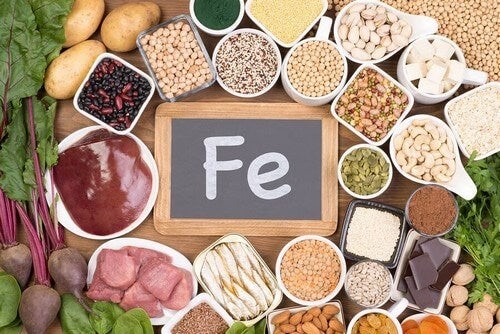
Sideremia and total iron binding capacity (TIBC): calculation, formula, transferrin values
TIBC (acronym from the English Total Iron Binding Capacity) is a parameter, detectable by a simple venous blood test, that indicates how well plasma proteins (particularly transferrin) are able to bind oxidised iron (Fe3+) and transport it into the circulatory stream
Remember that in the blood, transferrin can be found
- in free form (unsaturated transferrin, not bound to iron);
- in an iron-bound form (saturated, iron-bound transferrin).
The amount of bound transferrin coincides with the sideremia value.
The amount of transferrin available for iron binding and transport is reflected in the measure of total iron-binding capacity (TIBC), latent iron-binding capacity or transferrin saturation.
Since TIBC is an indirect measure of transferrin’s ability to bind iron, although transferrinemia and TIBC are two different tests, they have overlapping trends and essentially the same clinical significance.
TIBC calculation
This is a calculation for which it is necessary to determine the serum iron concentration (normal values: men: 12-25 µmol/L – women: 11-22 µmol/L) and transferrinemia.
Why is it useful to know the TIBC?
Determination of total iron-binding capacity is prescribed when abnormalities in iron metabolism are suspected.
In clinical practice, TIBC is generally assessed together with
- ferritinemia: the concentration of ferritin, the main protein involved in iron storage;
- transferrinemia: the concentration of transferrin, the main iron transport protein in the blood;
- sideremia: the proportion of circulating transferrin that is saturated with iron.
Normal TIBC values and sideremia/TIBC ratio
Normal values of total iron-binding capacity vary between: 240 and 450 μg/dL (43.0 – 80.6 μmol/L).
The ratio of sideremia to TIBC defines transferrin saturation, a figure usually expressed as a percentage.
Transferrin saturation = (sideremia/TIBC) x 100
Normal values men: 20-50%
Normal values for women: 15-50%.
Altered TIBC values
In a situation of iron deficiency, the body will do its best to take up as much iron as possible, transferrin will be less saturated, and the total iron-binding capacity will consequently be greater; conversely, in a situation where there is plenty of iron in the body (overload), TIBC will decrease so as not to encourage this overload.
Causes of a decrease in TIBC
A decrease in TIBC can occur in various conditions and diseases:
- iron overload;
- haemochromatosis;
- certain types of anaemia due to iron accumulation;
- haemolytic anaemia;
- malnutrition;
- acute and chronic inflammatory states;
- inflammation;
- hepatopathies such as cirrhosis, hepatitis, liver failure;
- nephropathies such as nephrotic syndrome;
- therapy with chloramphenicol or ACTH.
Causes of increased TIBC
An increase in TIBC can occur in various conditions and diseases:
- iron deficiency;
- Both overt and occult haemorrhages;
- sideropenic anaemias;
- hypoxaemic states;
- use of oral contraceptives;
- pregnancy (in the third trimester of gestation);
- breastfeeding;
- in children during growth.
Therapy
In the case of a TIBC alteration, treatment must be based on the underlying cause.
Iron-rich foods
Here is a list of various iron-rich foods (iron value expressed per 100 grams of product):
- Goose liver 30.53 mg
- Bitter dark chocolate 17.4 mg
- Clam 13.98 mg
- Bitter cocoa 13,86 mg
- Cooked oyster 11,99 mg
- Caviar 11,88 mg
- Canned chicken pate 9.19 mg
- Muesli with fruit and dried fruit 8.75 mg
- Muesli 8.20 mg
- Lentils 7.54 mg
- Oyster 6,66 mg
- Soya flour 6,37 mg
- Wheat germ 6,26 mg
- Chicken (leg) 6,25 mg
- Chickpeas 6,24 mg
- Boiled potatoes 6,07 mg
- Cuttlefish 6,02 mg
- Dried pine nuts 5,53 mg
- Cannellini beans 5,49 mg
- Fresh borlotti beans 5,00 mg
- Oat flakes 4,72 mg
- Hazelnuts 4,70 mg
- Anchovies in oil 4.63 mg
- Peanuts 4,58 mg
- Durum wheat 4,56 mg
- Dried almonds 4,51 mg
- Hazelnut and cocoa cream 4,38 mg
Read Also
Emergency Live Even More…Live: Download The New Free App Of Your Newspaper For IOS And Android
Iron Deficiency Anaemia: What Foods Are Recommended
Increased ESR: What Does An Increase In The Patient’s Erythrocyte Sedimentation Rate Tell Us?
Anaemia, Vitamin Deficiency Among Causes
Mediterranean Anaemia: Diagnosis With A Blood Test
Iron, Ferritin And Transferrin: Normal Values
Colour Changes In The Urine: When To Consult A Doctor
Why Are There Leukocytes In My Urine?
How Iron Deficiency Anemia (IDA) Is Treated
Thalassaemia Or Mediterranean Anaemia: What Is It?
Mediterranean Anaemia: Diagnosis With A Blood Test
Iron Deficiency Anaemia: What Foods Are Recommended
What Is Albumin And Why Is The Test Performed To Quantify Blood Albumin Values?
What Is Cholesterol And Why Is It Tested To Quantify The Level Of (Total) Cholesterol In The Blood?
Gestational Diabetes, What It Is And How To Deal With It
What Is Amylase And Why Is The Test Performed To Measure The Amount Of Amylase In The Blood?



